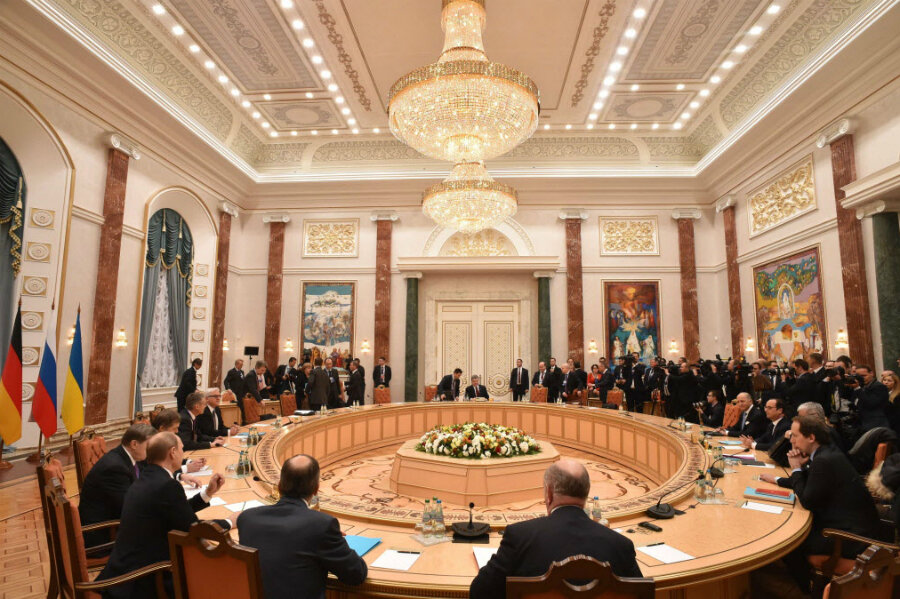Ukraine cease-fire: Can it avert slide into wider war?
| New York
Europe stepped back from the brink of a war threatening the Continent’s stability Thursday, as the leaders of Germany, France, Russia, and Ukraine reached a new cease-fire plan for Ukraine’s 10-month civil war.
While the United States has a longstanding and deep commitment to European security, it did not participate in these negotiations.
European leaders had said the high-level talks that opened in Minsk, the capital of Belarus, Wednesday afternoon represented perhaps the last opportunity to reverse a slide toward a wider war in Europe, and indeed, the outcome offered hope of a turning point to reestablishing peace.
But the 16 hours of difficult negotiations that it took to reach Thursday’s deal – and the questions that linger over the willingness of Ukrainian government forces and the Russian-backed separatists they are fighting to abide by the deal’s terms – suggest that Europe’s gravest security threat of the post-cold-war era may yet be far from settled.
The battle for Ukraine will not end with the Minsk meeting, most regional experts say, with the tug of war between Moscow and the Western-oriented government in Kiev likely to continue threatening wider risks to the European security order.
"I think most knowledgeable people will take the major points of the Minsk agreement with a huge grain of salt," says Dmitri Trenin, director of the Carnegie Moscow Center.
The cease-fire agreement may cool down the immediate conflict, he and other European security experts say. But, they add, long-term prospects for peace remain shaky since the interests and goals of the principal players, particularly Ukraine and Russia, are so disparate.
Perhaps the best that can be hoped for now, Mr. Trenin says, is that in the place of a hot and increasingly destructive war, "the situation will be frozen as to the terms of division in Ukraine and in Europe writ large."
The deal reached Thursday by German Chancellor Angela Merkel, French President François Hollande, Russian President Vladimir Putin, and Ukrainian President Petro Poroshenko sets the terms of a cease-fire to begin Sunday.
The deal calls for a “demarcation line” between government forces and the separatists, with the crucial compromise being that the rebels will pull back their heavy weapons from a cease-fire line that was set last September in a first – and failed – cease-fire deal, while the government is to withdraw its heavy weapons from the current front line. The difference is meant to create something of a buffer zone between the warring parties.
The talks in Belarus were based on the 12-point Minsk Protocol, which was reached in the same city last September but which was immediately violated and never took effect.
What's changed since then is that the violence has intensified, the separatists have gained a larger foothold, and that may be enough for all sides to want the violence to stop and, in effect, freeze the situation on the ground.
Under the new plan, the rebel-held regions in the east of the country along the Russian border are to achieve greater autonomy through constitutional reforms that are to be completed by the end of this year. Once the terms of that autonomy are in place, the Ukrainian government would also regain control of the country’s border with Russia.
Ukraine’s civil war has taken more than 5,400 lives since last April, and it has threatened to deteriorate into a proxy war between Russia and the West – and in particular the US, as some congressional leaders have ramped up pressure on President Obama to provide lethal arms to the outgunned Ukrainian government.
Russia insists it is not arming the rebels, but the increasingly sophisticated weaponry the separatists are using is largely of Russian provenance.
Thursday’s accord may calm immediate congressional calls for arming Ukraine, but Ukraine’s more hawkish supporters in Washington are not likely to back down – especially if the cease-fire unravels like the previous one.
“I don’t see this debate [over arming Ukraine] dying down at all,” says Eugene Rumer, director of Eurasian issues at the Carnegie Endowment for International Peace in Washington, speaking after the announcement of the cease-fire.
Even more striking in many respects, Mr. Rumer adds, is how the US was “completely absent” from the efforts to pull back from war in Europe, even as pressure to provide American arms to Ukraine increased. Mr. Obama and Mr. Putin did speak by telephone on the eve of the Minsk talks, Rumer notes, but the official readouts of the conversation from both sides “indicated they talked past each other.”
None of the leaders who hashed out the cease-fire agreement sounded overly optimistic about the long-term prospects for the accord. But they all expressed hope that the fighting, which had grown increasingly deadly in the days leading up to the Minsk talks, would be quelled.
Before the talks, the European Union’s foreign policy chief, Federica Mogherini, said the meeting would be “a turning point for good or for bad.” With no agreement, she said, “then all the options ... that one can imagine for Ukraine itself, but also for Europe, for relations between Russia and the EU and the rest of the world [would] at the least be worrying.”
The question now is whether the Minsk accord will be enough to put off some of those worrying scenarios.









